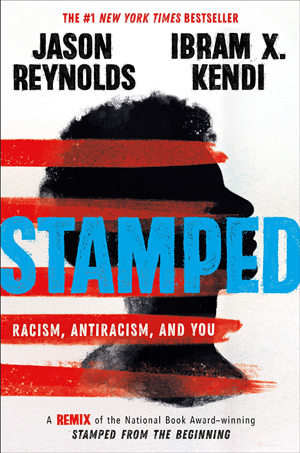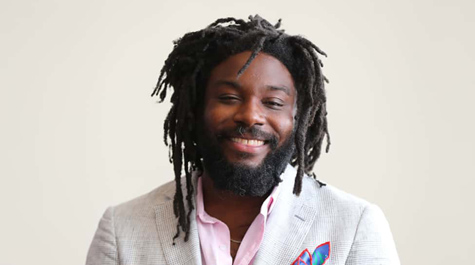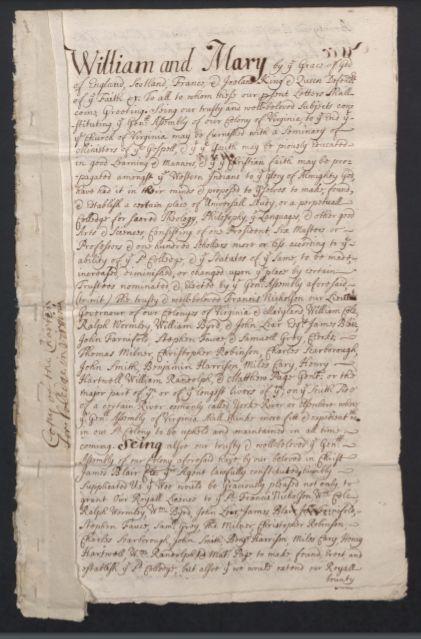This post is written by Graduate Student Apprentice, Phillip Emanuel, in conjunction with the W&M Libraries' One Book One Community program.
 W&M Libraries' One Book One Community program centers on Stamped: Racism, Antiracism, and You, by Jason Reynolds and Ibram X. Kendi.
W&M Libraries' One Book One Community program centers on Stamped: Racism, Antiracism, and You, by Jason Reynolds and Ibram X. Kendi.In the aftermath of the murder of George Floyd, protestors in Bristol toppled the statue of Edward Colston (1636-1721) in an act representative of an accelerated global reckoning with the legacies of enslavement and colonialism.[1] Colston was Deputy-Governor of the Royal African Company, the organization which represented England’s most significant governmental and business investment in the Atlantic slave trade. And the Governor under whom Colson worked was King William III, who succeeded his uncle and Queen Mary II’s father, James II.[2] It is therefore incumbent upon us to remember that many of the Africans brought to Virginia in chains were enslaved under the aegis and to the profit of the namesakes of our institution. Given the summer’s events and the university’s adoption of a land recognition statement in August, this Charter Day is a moment for us to further reflect on the ways in which racism and colonialism were baked into our university from the beginning. In the words of Jason Reynolds and Ibram X. Kendi in the book currently the focus of William & Mary Libraries and Williamsburg Regional Library’s "One Book, One Community" initiative, we are Stamped with these legacies.[3]
The William & Mary land acknowledgement notes that the university is built on land originally inhabited by the "Cheroenhaka (Nottoway), Chickahominy, Eastern Chickahominy, Mattaponi, Monacan, Nansemond, Nottoway, Pamunkey, Patawomeck, Upper Mattaponi, and Rappahannock tribes."[4] But a reading of the Charter reminds us that not only is this campus built upon traditional Indigenous land, but also that expropriated Indigenous lands financially supported the project from its beginning. Three essential elements of the funding plan were based on exclusive European possession and exploitation of land taken from these traditional owners – from quit rents (payments to the Crown from landholders), with proceeds from the Surveyor-General’s office (responsible for surveying land as part of its alienation from Indigenous systems of land ownership), and by the expropriation of 20,000 acres from the tribal lands of the Pamunkey, Nansemond, Nottoway, and Weyanock nations.[5] The Charter thus enshrined our institution’s role in the European settlement of Indigenous lands to fund its operations as one of the pillars of settler colonialism.[6]
 Jason Reynolds
Jason ReynoldsThe other major funding source provided by the Charter was a duty on tobacco grown by enslaved Africans and Indigenous peoples.[7] As the Lemon Project has shown again and again, William & Mary invested directly in the enslavement of people of African descent over generations and depended upon their labour.[8] That exploitation is also written into the Charter itself in the tobacco duty and hinted at in the names of those who were involved in the founding. The men named in the Charter as Visitors or officials of the College directly enslaved people. One, Lieutenant-Governor Francis Nicholson, even gave the College an enslaved man named Price as a gift in 1704.[9] The monetary value assigned to Price by his enslavers, £30, was the same as that of a person of African origin arriving on the ships of the Royal African Company headed by our founders and benefactors. Price was one of many whose labour sustained this institution, along with the unnamed thousands who worked in the tobacco fields, which paid the bills with the profits they drew from Indigenous land.
 Copy of the Royal Charter, 1693, likely made for
Copy of the Royal Charter, 1693, likely made for
Sir Edmund Andros.
https://digitalarchive.wm.edu/handle/10288/20102 William & Mary has made considerable steps to recognize and respond to both its legacy of racism and its role in slavery and settler colonialism. More remains to be done. The events of the past summer, the necessary activism and messages of the Movement for Black Lives, and the disproportionate impact of the Covid-19 pandemic on communities of colour should serve as reminders that the racist legacies enshrined in modern society by actions and ideas rooted in the past still shape all of our lives and those of our local communities. Given that the celebration of our institution’s founding always falls in Black History Month, it should serve as an annual reminder of the struggle with our legacy and an opportunity to renew our promise to do better. This Charter Day, and every day after it, we must remember that ours is an institution "stamped from the beginning" with racism, slavery, and colonialism.[10] Only by remembering and taking action to change those structures can we move forward.
[2] ‘The Royal African Company did this day at a General Court unanimously choose his Highness the Prince of Orange to be their Governor for the year ensuing; And did present his Highnesse with 1000 l. in their Joint Stock, which is about 2000 l. in value.’ 16.01.88/89, London Gazette, issue 2420, 17-21/01/88/89, https://www.thegazette.co.uk/London/issue/2420/page/2, last accessed 05.02.21.
[3] Jason Reynolds and Ibram X. Kendi, Stamped: Racism, Antiracism, and You, (New York: Little, Brown, and Company, 2020).
[6] For a more detailed discussion of the Charter and William & Mary’s relationship to Indigenous peoples and involvement in settler colonialism see Danielle Moretti-Langholtz and Buck Woodard, eds, Building the Brafferton: The Founding, Funding, and Legacy of America’s Indian School, (Williamsburg: Muscarelle Museum of Art, 2019). On the question of funding for the College see in particular Woodard and Moretti-Langholtz, ‘”To Be Supported and Maintained in all time coming”: Funding the College of William & Mary and the Brafferton Indian School’, 78-99.
[7] Clause XV. ‘Royal Charter’.
[8] For the ongoing work of the Lemon Project, including the report on the first eight years, see ‘The Lemon Project: A Journey of Reconciliation’, https://www.wm.edu/sites/lemonproject/, last accessed 05.02.21.
[9] Jennifer Oast, ‘“So Large a Family as the College”: Slavery at the College of William and Mary,’ Institutional Slavery: Slaveholding Churches, Schools, Colleges, and Businesses in Virginia, 1680-1860, (Cambridge: Cambridge University Press, 2016), 126-58. See also Craig Steven Wilder, Ebony and Ivy: Race, Slavery, and the Troubled History of America’s Universities, (New York: Bloomsbury Press, 2013), especially 42-44.
[10] Ibram X. Kendi, Stamped from the Beginning: the Definitive History of Racist Ideas in America, (New York: Bold Type Books, 2016).